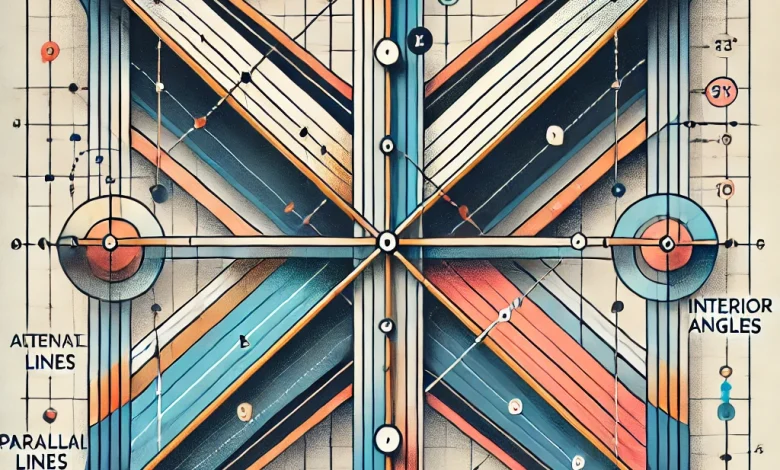10 Must-Know Facts About Alternate Interior Angles for Geometry Success

Table of Contents
Introduction to Angles and Geometry
Geometry is one of the most fundamental branches of mathematics, forming the basis for various real-world applications. Angles, a cornerstone concept in geometry, are essential for understanding shapes, structures, and spatial reasoning. Among these, alternate interior angles hold particular importance, especially in studying parallel lines and transversals. Grasping their properties and relationships enables deeper insights into geometric principles.
Alternate Interior Angles: Basic Definition
What Are Alternate Interior Angles?
Alternate interior angles are pairs of angles located between two lines, on opposite sides of a transversal. They form when a transversal cuts through two lines.
For example, if two parallel lines are intersected by a transversal, the angles on opposite sides of the transversal but within the space between the two lines are alternate interior angles.
How Are They Different from Other Angles?
Unlike corresponding angles, which lie in the same relative position at each intersection, or consecutive interior angles, which are on the same side of the transversal, alternate interior angles are non-adjacent and on opposite sides of the transversal.
Key Properties of Alternate Interior Angles
- Equal in Measure: When the lines are parallel, the alternate interior angles are always equal.
- Non-Adjacent Angles: These angles never share a common vertex.
- Opposite Sides of the Transversal: They lie on alternate sides, giving them their name.
Proof of the Property
Consider two parallel lines, l1l_1l1 and l2l_2l2, cut by a transversal ttt. Using the definition of parallel lines and supplementary angles, it can be shown that alternate interior angles are congruent.
Alternate Interior Angles Theorem
Statement of the Theorem
The Alternate Interior Angles Theorem states:
“If a transversal intersects two parallel lines, then the alternate interior angles are equal.”
Proof of the Theorem
- Identify two parallel lines and a transversal.
- Use the property of supplementary angles between the transversal and one of the parallel lines.
- Show that alternate interior angles have equal measures.
- Use corresponding angle relationships to complete the proof.
This theorem forms a critical part of solving geometric problems.
Converse of the Alternate Interior Angles Theorem
Definition and Statement
The converse theorem states:
“If two lines are intersected by a transversal and the alternate interior angles are equal, the lines are parallel.”
Proof and Application
The converse helps establish the parallelism of lines by verifying the equality of alternate interior angles. This is widely used in proofs and constructions.
Conditions for Alternate Interior Angles to Be Equal
Alternate interior angles are only equal if the lines being intersected by the transversal are parallel. For non-parallel lines, these angles will differ in measure.
Example
If two non-parallel lines are intersected by a transversal, the alternate interior angles may not match, as their equality depends entirely on the parallel nature of the lines.
Alternate Interior Angles in Real-Life Applications
Applications in Architecture
Alternate interior angles are essential in designing parallel structures like bridges and roofs. The alignment of beams often relies on understanding their relationships.
Engineering and CAD
In engineering, software like AutoCAD uses alternate interior angles for creating precise designs and ensuring symmetry in structures.
Practical Examples and Problem-Solving
Understanding alternate interior angles becomes easier through practical examples. Here are detailed problem scenarios to deepen your comprehension:
Example 1: Finding Unknown Angles
Two parallel lines, l1l_1l1 and l2l_2l2, are intersected by a transversal ttt. One of the alternate interior angles is given as 65∘65^\circ65∘. Find the measure of the other alternate interior angle.
Step-by-Step Solution:
- Identify the Given Angle:
The problem states that one alternate interior angle is 65∘65^\circ65∘. - Apply the Property of Alternate Interior Angles:
When the lines are parallel, the alternate interior angles are congruent. This means they have the same measure. - Write the Conclusion:
The other alternate interior angle also measures 65∘65^\circ65∘.
Extension to Unknown Variables:
Suppose the measure of one alternate interior angle is given as (3x+5)∘(3x + 5)^\circ(3x+5)∘, and the other angle is (5x−15)∘(5x – 15)^\circ(5x−15)∘. Solve for xxx:
- Set the angles equal: 3x+5=5x−153x + 5 = 5x – 153x+5=5x−15.
- Simplify: 20=2×20 = 2×20=2x.
- Solve for xxx: x=10x = 10x=10.
- Substitute xxx back into either expression to find the angle measures.
This type of problem demonstrates how alternate interior angles are used in algebraic contexts.
Example 2: Proving Lines Are Parallel
Two lines, l1l_1l1 and l2l_2l2, are intersected by a transversal ttt. The alternate interior angles formed are each 75∘75^\circ75∘. Prove that l1l_1l1 and l2l_2l2 are parallel.
Step-by-Step Solution:
- Identify the Angle Measures:
Both alternate interior angles are given as 75∘75^\circ75∘. - Apply the Converse of the Alternate Interior Angles Theorem:
If alternate interior angles are equal, the lines intersected by the transversal are parallel. - Write the Conclusion:
Since 75∘=75∘75^\circ = 75^\circ75∘=75∘, the lines l1l_1l1 and l2l_2l2 are parallel.
Real-Life Connection:
In construction or architecture, this principle is used to check whether structural elements are aligned parallel by measuring angle congruency.
Example 3: Finding an Unknown Angle in a Complex Diagram
Suppose a transversal cuts two parallel lines, forming a set of alternate interior angles. One angle is 110∘110^\circ110∘, and another angle in the diagram (not alternate) is adjacent to this angle. Find the measure of all related angles.
Step-by-Step Solution:
- Identify the Given Angles:
One alternate interior angle is 110∘110^\circ110∘. The adjacent angle to it forms a linear pair. - Find the Adjacent Angle:
Linear pairs are supplementary, so the adjacent angle is 180∘−110∘=70∘180^\circ – 110^\circ = 70^\circ180∘−110∘=70∘. - Determine the Other Alternate Interior Angle:
By the property of alternate interior angles, the other angle is also 110∘110^\circ110∘. - Write the Conclusion:
The angles in the diagram are 110∘,70∘,110∘,110^\circ, 70^\circ, 110^\circ,110∘,70∘,110∘, and 70∘70^\circ70∘.
Example 4: Using Alternate Interior Angles to Solve Geometry Proofs
Problem:
In a triangle, two of its sides are extended to form two parallel lines. A transversal crosses these lines, creating alternate interior angles with the triangle’s internal angles. Use the property of alternate interior angles to prove that the sum of the triangle’s internal angles is 180∘180^\circ180∘.
Solution:
- Draw a diagram showing two parallel lines cut by a transversal passing through the triangle.
- Identify the alternate interior angles that align with the triangle’s angles.
- Use the property that alternate interior angles are equal to the corresponding internal angles.
- Conclude that the sum of the triangle’s angles equals 180∘180^\circ180∘, as they align with a straight angle along the transversal.
Encouragement for Problem-Solving
To master the concept of alternate interior angles, practice is key. Use the following approaches:
- Draw detailed diagrams to visualize alternate interior angles.
- Solve problems involving algebraic expressions and angle relationships.
- Practice proofs using theorems like the Alternate Interior Angles Theorem and its converse.
- Work on real-world geometry problems, such as determining parallelism in design or construction.
By solving a variety of problems, you’ll build confidence and strengthen your understanding of alternate interior angles in geometry.
Misconceptions and Clarifications
Common Misconceptions
- Confusion with corresponding angles.
- Misidentifying alternate interior angles when lines are non-parallel.
Tips to Avoid Mistakes
Always check the relative positions of angles and verify the parallel nature of the lines to identify alternate interior angles accurately.
Relationship to Other Angle Pairs
Comparison with Corresponding Angles
Corresponding angles are on the same side of the transversal, while alternate interior angles are on opposite sides.
Alternate Exterior and Consecutive Interior Angles
Alternate interior angles share similarities with alternate exterior angles but differ in position. Consecutive interior angles are supplementary when the lines are parallel.
Advanced Applications in Mathematics
In trigonometry and coordinate geometry, alternate interior angles are pivotal in solving complex proofs, determining slopes, and understanding relationships between parallel and perpendicular lines. Competitions and advanced mathematical problems often incorporate these concepts for deeper exploration.
Importance of Visual Tools and Technology
Visual tools and advancements in technology have transformed the way geometric concepts are learned. By using interactive resources, learners can easily understand and engage with complex ideas through practical and visual experiences.
Role of Dynamic Geometry Software
Software like GeoGebra, Desmos, and Cabri Geometry provides a dynamic platform for exploring geometric relationships. These tools enable real-time visualization and help students build a deeper understanding of geometric principles.
- Interactive Visualization:
Users can create and manipulate diagrams, including lines and angles, to explore geometric properties dynamically. Adjusting diagrams visually allows for a clearer understanding of the relationships among angles. - Real-Time Feedback:
These tools provide instant feedback. For example, moving points in the diagram shows how the measures of angles change, offering insights into the conditions that maintain or alter specific relationships. - Customization for Clarity:
Platforms like GeoGebra allow users to add labels, apply colors, and annotate diagrams, making geometric concepts easier to grasp and recall.
Benefits of Using Technology in Geometry
- Engagement and Interactivity:
Interactive tools make diagrams more engaging compared to traditional textbooks. They offer students an opportunity to interact with the figures, enhancing their learning experience. - Enhanced Conceptual Understanding:
Visualization helps learners see how specific relationships remain consistent under certain conditions, providing intuitive learning experiences. - Connecting Theory to Practice:
Graphing tools enable students to represent equations visually, connecting algebra and geometry in a seamless way. - Room for Exploration:
With such tools, students can freely explore how various geometric configurations behave, helping them understand related concepts more effectively. - Advanced Features:
Tools like Wolfram Alpha guide learners through challenging problems step-by-step, offering detailed insights into advanced problem-solving.
Using GeoGebra for Geometry
- Creating Diagrams:
Use GeoGebra to draw lines and add a transversal. This setup helps illustrate relationships between angles clearly. - Label and Measure:
Use built-in features to measure and label angles, aiding in visual comprehension. - Experiment and Observe:
Alter diagrams interactively to explore how different configurations impact angle measures. - Explore Variations:
Deactivate the parallel property of lines and observe how changing conditions affect angle relationships.
Applications Beyond Academics
- Architecture and Design:
Architects leverage geometry to design precise and symmetrical structures. Software like AutoCAD incorporates these principles in drafting plans. - Engineering:
Engineers analyze structures and optimize designs using tools that calculate angles and distances. - Animation and Game Design:
Designers rely on geometric principles to ensure accuracy in 3D modeling and animations. - Navigation:
Geometry plays a role in mapping and navigation, ensuring accurate routes and spatial calculations.
Why Visual Tools Are Crucial
- Simplify Complex Ideas:
Tools provide a way to visualize and validate geometric relationships, making even challenging concepts easier to understand. - Encourage Independent Learning:
Interactive platforms let students explore at their own pace, fostering curiosity and better comprehension. - Support Collaboration:
Many tools offer collaborative features that promote teamwork and shared learning experiences. - Integration with Classroom Tech:
Platforms like Google Classroom integrate seamlessly with these tools, making them more accessible for teachers and students alike.
Popular Tools for Exploration
- GeoGebra: Free, interactive, and ideal for visualizing relationships among lines and angles.
- Desmos: Known for graphing capabilities but also supports geometric constructions.
- Wolfram Alpha: Provides solutions to geometric problems in detailed steps.
- Khan Academy: Offers interactive lessons with a focus on building foundational skills.
- Geometry Apps: Mobile tools like Geometry Pad help users learn on the go.
Future Innovations in Geometry Learning
Emerging technologies like augmented and virtual reality (AR/VR) are enhancing the way geometry is taught and understood:
- AR: Mobile apps project visual representations of angles onto real-world objects, offering an interactive way to connect theory to practice.
- VR: Platforms simulate 3D environments, allowing users to explore geometric relationships in a hands-on way.
Encouraging Tech-Based Learning
Incorporating technology into learning transforms abstract ideas into practical and relatable concepts. Platforms like GeoGebra and Desmos enhance the learning process, making complex ideas more accessible. Through experimentation and active engagement, students can deepen their understanding and appreciation for geometry.
By utilizing these tools, learners can gain valuable insights into both fundamental and advanced topics, building skills that are applicable to academic, professional, and everyday contexts.
Conclusion
Geometry is a fundamental branch of mathematics, and understanding the relationships between angles is crucial for solving many problems and exploring advanced concepts. The study of angles formed by parallel lines and transversals offers insights into symmetry, balance, and structure, making it relevant in both theoretical and practical applications.
Modern tools and technologies, such as GeoGebra, Desmos, and other dynamic geometry software, have revolutionized how learners approach and understand these relationships. These tools not only make complex geometric ideas more accessible but also encourage experimentation, allowing learners to connect mathematical principles with real-world scenarios. Whether it’s in architectural designs, engineering projects, or navigation systems, the practical application of these geometric principles underscores their importance in everyday life.
By leveraging interactive resources and practicing consistently, learners can build a strong foundation in geometry. This foundation will enable them to tackle more advanced topics, improve problem-solving skills, and gain a deeper appreciation of the role geometry plays in our world.
FAQs
1. What are alternate interior angles, and where are they found?
These angles are pairs of non-adjacent angles that are on opposite sides of a transversal, located between two lines that the transversal intersects.
2. Do these angles always have the same measure?
They are equal in measure only when the two lines intersected by the transversal are parallel. If the lines are not parallel, the measures will differ.
3. How can I identify alternate interior angles in a diagram?
To identify them, locate a transversal cutting across two lines. Look for pairs of angles positioned between the lines on opposite sides of the transversal.
4. What role do these angles play in proving lines are parallel?
The converse of the Alternate Interior Angles Theorem states that if these angles are equal, the two lines intersected by the transversal must be parallel.
5. What are some common mistakes when identifying these angles?
One common mistake is confusing them with corresponding or same-side interior angles. It’s essential to note their position between the two lines and on opposite sides of the transversal.
6. How can I practice understanding angle relationships effectively?
Using dynamic geometry tools like GeoGebra or Desmos can help you create and manipulate diagrams interactively. This allows you to experiment with various configurations and gain a better understanding of angle relationships.
7. Are there any practical applications of these angles in real life?
Yes, they are used extensively in architecture, construction, navigation, engineering, and even in computer-aided design for creating precise alignments and measurements.
8. How can technology improve my understanding of geometry?
Technology offers interactive visualizations and real-time feedback, making complex concepts easier to grasp. Platforms like GeoGebra allow users to manipulate geometric figures and explore properties dynamically.
9. What’s the difference between alternate interior angles and alternate exterior angles?
Alternate interior angles are located between the two intersected lines, while alternate exterior angles are found outside these lines, also on opposite sides of the transversal.
10. Why are these angles important for geometric proofs?
They form the basis of many theorems and proofs in geometry, particularly those involving parallel lines. Understanding their properties is essential for solving problems and constructing logical arguments.
11. Can I use angle relationships to solve real-world problems?
Absolutely. Engineers, architects, and designers use these principles to ensure precision and accuracy in their work. They are also critical in navigation and mapping.
12. What tools are best for exploring these concepts?
GeoGebra, Desmos, and similar geometry applications are excellent for visualizing and practicing angle relationships. These tools allow users to create dynamic models and observe how changes affect the relationships.
13. Are there advanced mathematical topics that build on this concept?
Yes, concepts involving these angles are foundational for studying trigonometry, coordinate geometry, and calculus. They also play a role in advanced problem-solving and mathematical proofs.
14. How does understanding these angles help in competitive exams?
Competitive exams often test logical reasoning and problem-solving skills. Familiarity with geometric relationships, including angle properties, can help solve a variety of questions efficiently.
15. What should I do if I’m struggling with angle-related concepts?
Start by revisiting the basics and practicing with diagrams. Use dynamic tools to visualize the relationships, and don’t hesitate to ask for help or explore online tutorials for additional support.



